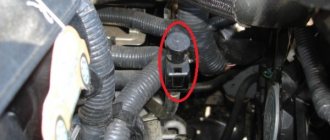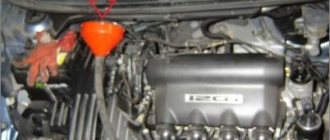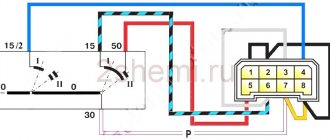A CVT gearbox (common name - variator) is a continuously variable gearbox. The international name for this structural element is Continuously Variable Transmission (CVT). The functions of the variator are:
- Receiving informative signals from switches and sensors and processing them;
- Stabilization of pressure in the engine during vehicle operation;
- Switching gears while driving.
Manufacturers of Toyota Rav 4 state that changing the oil in a CVT transmission is not a mandatory procedure. However, the official point of view differs from the position of the majority of car owners. If you do not change the technical substance once every 2 years (approximately 45,000 kilometers), the Toyota Rav 4 systems may overheat, which will entail the risk of an emergency breakdown.
Below are signs of the need to change the oil in the Toyota Rav 4 variator :
- The used transmission lubricant has changed its original shade to a more cloudy one. The oil used has a burning and soot smell, a thick, heterogeneous consistency and foreign metallized particles;
- When the Toyota Rav 4 engine is running, significant noise is heard;
- When driving, the vehicle moves unevenly - jerkily. In some cases, the car does not budge at all;
- When starting the Toyota Rav 4 engine, excessive vibrations are felt.
The car enthusiast should take into account that problems when operating a Toyota Rav 4 car can arise not only when there is a shortage or low quality of transmission lubricant, but also when there is an excess of it. In this case, unexpected difficulties appear when changing gears. If you suspect any problems with this technical fluid, you should check the oil in the Toyota Rav 4 variator. This procedure is performed as follows:
- The vehicle is placed on a flat surface. It is recommended to ensure that the vehicle is in the most horizontal position possible, without ups or downs. Otherwise, there may be errors in the oil level reading;
- Start the Toyota Rav 4 engine;
- Stop the engine, but do not wait for it to cool down. It is necessary to measure the oil level in the car's variator until it has cooled down;
- A dipstick is removed from the hole in the variator. Most often, the outer part of this part is presented in the form of a yellow ring. The dipstick should be thoroughly wiped with a dry cloth or towel and immersed back in the transmission lubricant;
- Take out the dipstick again and check which of the marks located on it reaches the oil in the variator. If the technical fluid level is at the middle mark of the dipstick, slightly higher or slightly lower, this is a good indicator. If the transmission lubrication indicator exceeds o or is at or below o, then it is necessary to take action.
When checking the level of transmission lubrication in the variator, it is important to pay attention to its condition. If the consistency or smell of the oil has changed, it should be replaced.
Oil change intervals
The variator uses a special type of oil, because The very principle of operation of this unit is not similar to conventional automatic transmissions. Such a product is marked with the letters “CVT”, which in translation from English. language means “continuously variable transmission”.
The properties of the lubricant differ significantly from ordinary oil.
According to the recommendations of professionals, the lubricant in CVT gearboxes should be changed no later than every 30,000-40,000 km on the speedometer. It's better to change a little earlier.
With an average load on the car, this mileage corresponds to 3 years of operation.
The owner determines the frequency of fluid changes independently, but it is recommended not to exceed 45 thousand km.
Signals to change the lubricant:
- The mileage has reached the limit for replacement (45,000 km).
- The color of the oil has changed significantly.
- An unpleasant odor appeared.
- A solid mechanical suspension was formed.
The vehicle's controllability depends on timely work carried out.
How to change the oil in a Toyota Rav4 variator
You can do a partial oil change in the Toyota Rav4 variator yourself in a garage where there is a lift or inspection hole. The operation does not require any special tools or devices.
Preparing for replacement
It is necessary to purchase at least 5 liters of transmission fluid in advance. In addition, you need a new variator oil pan gasket with the manufacturer's number:
- 35168-6310 – for models with a production date before 08.2008;
- 35168-20010 – for all models.
Metal-plastic filter - 35330-DW040 or 35330-DW090.
Freeing up the working area on the Rav4 for an oil change
The engine compartment protection should be removed.
Using socket heads or spanners, unscrew the four front bolts (1) and two rear bolts (2). Depending on the design, the protection can be attached to the body using self-tapping screws. In any case, removing the protection is not difficult.
For more convenient access to the mounting points of the variator tray, the crossbar in the front part of the body is removed. It is necessary to unscrew the four fastening points with heads at “17”.
View of the Toyota Rav4 CVT pan.
It is necessary to clean the sides of the variator from dirt so that it does not accidentally get inside the unit when dismantling the pan.
How to change the oil on a 5th generation Toyota 5Runner
4th generation 4th generation oil change2018-06-112018-06-19https: //trail4runner.com/wp-content/uploads/2017/08/Trail_4R_Logo-4.pngTrail4R. com - 5th generation 4Runner Modshttps: //trail4runner.com/wp-content/uploads/2018/06/5th_gen_4runner_oil_change_01.jpg200px200px
Step by Step 5th Generation 4Runner Oil Change
Oil change
How to change a 5th generation Toyota 4Runner
There are many different types of maintenance that you can perform on a vehicle, but perhaps the most important is changing the oil in your car. If you want a reliable and long-lasting car, I would suggest changing the oil every 5,000 miles. You may not have to change it quite often with synthetic oil, but it's worth it. You really should only use synthetic oil like Mobil 1. Although the 4Runner is pretty bulletproof, oil changes are necessary and will only help in a smoother, longer lasting car.
WHAT YOU NEED
There are some key components that you will need to change the oil on your 5th gen 4th gen. Here is a list of everything you will need:
HOW TO CHANGE YOUR OIL - STEP BY STEP
Step 1 - Good Location
The first step is to find a place to change the oil in your car. I can fit under my 4Runner without any ramps or lifts; however, if you need or prefer to lift the vehicle, do so accordingly.
Step 2 - Get some latex gloves
Prepare to change your 4Runner's oil by wearing latex gloves. While it's not necessary, I think it's best to try to keep your hands as clean of oils and grease as possible. Using gloves also helps with quick cleanup because sometimes grease can be very difficult to come off of your hands.
Step 3 - Remove the skid plate cover
If your 4Runner is equipped with a front skid plate, you will need to remove a small cover located on the skid plate which will give you access to the oil drain plug.
You will need to remove this cover using a 12mm socket and ratchet. After removing the bolts, install a small skid plate that covers the oil drain plug to the side. I suggest placing the bolts on the top of this small skid plate so you can easily find them once it's time to put that cap back in place.
Step 4 - Remove the Oil Drain Plug
Prepare to remove the oil drain plug and drain the oil from the 4Runner. To do this, you will need a container to catch any spilled oil below. Although some oil is lost due to the operation of the vehicle, plan to lose at least 6.6 quarts (as this is the amount you put in).
After placing a container to catch the oil under the drain plug, use a 14mm socket and ratchet to unscrew the drain plug. Once the drain plug is loose enough, unscrew it by hand.
Be sure to hold onto the drain plug and try not to drop it into the oil container. Once you remove the drain plug, the oil will flow out quickly, so be prepared to move your hand out of the way and let the oil drain into the container.
In the meantime, you can go ahead and wipe any dirt off the drain plug with a clean microfiber cloth. After that, set the drain plug aside for later.
Step 5 - Remove the Front Skid Plate and Cover
While the oil is draining, go ahead and remove the front skid plate and skid plate cover. You may be asking why you should do this, and the simple reason is to change the oil filter. You will not have access to the oil filter unless you remove the front skid plate and skid plate cover.
To remove the cover, you will need a 10mm socket and a ratchet to remove five (5) bolts. There is also one (1) push pin that you will need to remove. Once you remove the cover, you will have access to remove all four (4) bolts that secure the skid plate.
To remove these bolts, use a 12mm socket and ratchet. Tips that are very important: First remove the front bolts from the skid plate. After this, you will need to hold the skid plate while removing the two back ones at the same time. If you don't hold the base plate when removing the last bolt, the base plate will fall and hit you. Although it doesn't weigh too much, it probably won't feel good. The front of the skid plate is on a hinge that releases.
Take your time and rotate the back of the skid plate toward the ground to remove the skid plate from the hinge. Once you remove the skid plate, install it to the side with the bolts or side by side.
Step 6 - Remove the Oil Filter
At this point, you'll want to remove the oil filter - which I think is the most difficult part of the whole process, but is still quite simple. Before removing the filter, reinstall the drain plug and the small skid plate that covers the drain plug. After this, move the container you are using to catch the oil so that it is under the oil filter.
Using a 3/8-inch extension ratchet, remove the metal plug from the oil filter. Some oil will drip, so make sure you have a container to catch it. Your new oil filter should come with a plastic tool to drain the oil later. All you have to do is insert it into the base of the filter. The oil should then drain out. Wait for the oil to drain and remove the plastic drain tool. Along with removing the plastic drain tool, a small O-ring should also appear. It's trash, so throw away the drain tool and the small O-ring.
Now you can remove the filter itself. Use a 64mm filter wrench and remove the filter housing. Be sure to pay attention to the small metal latch on the side of the case. This tab should be aligned in the same location when you turn the filter back on. After unscrewing the filter completely, remove the old filter from the housing and discard it.
There is also an O-ring on the body that needs to be removed. You don't need any prying tools and you can easily remove this o-ring by hand. I recommend doing this by hand as you don't want to damage the plastic threads.
Step 7 - New O-ring from the filter box
Take the new O-ring from the filter box and apply a small amount of oil to it. After that, place it on the filter housing. Make sure it fits all the way around. Then place the new filter into the housing. You don't have to worry about orientation as there is no right way.
Step 8 - Screw the filter assembly back into
Be sure to continue tightening until the metal indicator tab returns to its original position as it was before removing the filter housing. Now install the small O-ring into the filter housing by first coating it with a little oil and then placing the O-ring in place in the drain area of the filter housing. After this, you can install the metal drain plug into the filter housing. You don't need to draw this out too long, so just make sure it's neat.
Step 9 - Oil Change
After checking that the drain plug and oil filter are back in place, install 6.6 quarts of 0W-20 oil in your 4Runner. Use a funnel for this as you don't want to spill any oil on the engine.
Step 10 - Check for Leaks
Once all 6.6 quarts of oil have been installed, check around the drain plug and filter housing to make sure there are no leaks. If you can't spot any, you can go ahead and install the skid plate and skid plate cover.
Step 11 - Resetting the Maintenance Light
Now that you have completed the actual oil change procedure, you need to reset your maintenance light so you know when it needs to be changed. To do this you will need your car key.
Turn the key to accessory mode (as far as the key will go without actually starting the car).
Make sure your odometer shows trip A. If it doesn't, press the knob to the right of the speedometer to move to trip A.
After checking for shutdown A, turn the key to the off position. Press and hold the odometer button and then return the key to accessory mode. The screen should show factory reset.
Continue holding the odometer button until the maintenance light is reset. After that, you can drive another 5,000 miles.
CONCLUSION
While there are some vehicles that make oil changes a little easier, the 4Runner's oil can be changed relatively easily and in a short amount of time.
Since the 4Runner is capable of working in some pretty tight places, you'll need to take the time to maintain your vehicle as best as possible and avoid potential damage.
Taking the time to change your oil every 5,000 miles with a quality synthetic like Mobil 1 will only improve your vehicle's performance, durability and reliability on the track and on the open road.
The dirty truth about how often you need to change your oil
Changing your oil is just one of the many small hassles that come with car ownership, but they are essential to keeping your car in good shape. Additionally, if you don't change your oil on time and with the right products, it could void your vehicle's warranty.
However, experts now say that the standard oil change interval of every three months—or every 3,000 miles (4,828 kilometers)—is old news, and most cars can only go a little further before needing an oil change. If you're changing your oil more often than necessary, this will not help your car. This doesn't hurt either, but you're wasting money, time and resources. Remember also that throwing away oil that is still usable puts a strain on the environment.
There are four main "recommended" oil change intervals, depending on factors specific to you and your vehicle:
- Every 1,000 miles (1,609 kilometers) or every six months
- Every 3,000 miles (4,828 kilometers)
- Every 5,000–7,500 miles (8,046–12,070 kilometers)
- Every 10,000–15,000 miles or every six months (16,093–24,140 kilometers)
Let's look at the circumstances for each.
Change every 1000 miles
First, if some experts say 3,000 miles is too often, why do those same experts recommend intervals every 1,000 miles? It all depends on your driving habits. If your driving pattern consists primarily of trips of 10 miles or less, you should consider changing your oil more frequently than every 3,000 miles for two reasons.
- Unless you drive for long periods of time at high, steady speeds (like on the highway), your engine doesn't get hot enough to boil off the condensation that builds up in the system. This can cause the oil to break down more quickly.
- Most of the wear and tear on your engine happens when you start your car, and unless you drive very far, most of your driving is very hard on your engine. More frequent oil changes will help minimize the damage.
In short, if you drive your car infrequently because the mileage is much less than the recommended service interval, you should still change the oil twice a year since oil degrades over time.
change more often
Some auto experts believe the 3,000-mile interval is actually beneficial for oil change shops because the more often you come in, the more money they make. However, if you have an older model car that recommends this interval, you're probably better off sticking with it.
Scientific American is suitable for longer intervals, especially every 5,000 to 7,500 miles, based on the assumption that this is what most car owner's manuals recommend. Intervals between 5,000 and 7,500 miles are becoming more common, although some manufacturers recommend taking your driving style into account as well. and habits.
For example, if your car is fairly new and you typically drive for 20 minutes or more at fairly steady speeds (as opposed to stopping and cruising while driving), you're a prime candidate for extending the time between oil changes. However, if your car older, it is better to adhere to the manufacturer's recommended maintenance schedule.
Change every 10,000 miles
If your vehicle's manufacturer recommends synthetic oil, or if you decide to make the switch, you could go up to 10,000 miles or more between oil changes. Although synthetic oil is much more expensive than conventional oil, it has more benefits. It works better than regular oil (see "It's Interesting," below) and is better for the environment.
Opinion differs, however, on whether the upgrade is worth it. While some experts suggest doing it in most cases, Consumer Reports says that, as a general rule, you shouldn't upgrade to a synthetic unless your vehicle needs it. If you frequently tow heavy loads, synthetic oil can help reduce the strain on your engine. If you have a model that is known to be prone to sludge problems (that is, when your engine is clogged with degraded oil residue), synthetic oil can help solve these problems and extend the life of your engine.
What do these lights on the dashboard mean?
It's best to keep track of the miles you drive between oil changes, although some cars make this easier with an indicator that tells you it's time to go to the store, as part of what's called an oil life monitoring system. These systems track your mileage and also use data of your driving, which are analyzed by your car's computer to determine when your car needs an oil change. When the light comes on, it's best to change the oil as soon as possible, but it doesn't have to be urgent.
If your vehicle has an oil life monitoring system, please note that this light is different from the oil pressure light, which lights up on the dashboard if your vehicle's oil is not flowing properly due to low levels, a faulty oil pump, leaks in the system or some other issue. Learn the difference between the two turn signals because if the oil pressure light comes on, you need to stop driving as soon as possible to avoid engine damage.
Get into the habit of checking your oil at least once a month to make sure your car isn't leaking or burning oil. If the level is low, add oil. Good oil should be a clear brown-black color, although the Automobile Association of America warns that color is not the only indicator of oil life. If the oil is cloudy or opaque, it may be time for a change, and if it's milky, your engine may be leaking coolant. If your car has one of the above oil monitoring systems, you may not have a dipstick to check your oil.
Moral of the story? If you are unsure how often to change your oil or how to check your oil between oil changes, consult your owner's manual. These habits will help ensure the longevity of your engine.
,
The procedure for changing the oil in the Rav 4 variator
Let's describe the oil change in the Rav 4 variator:
- The car is driven into the inspection hole.
- The crankcase protective casing is removed . To achieve even more space, you can additionally remove the crossbar .
- Use a 6mm hex to unscrew the drain plug , under which a container for receiving waste is pre-installed. About a liter of oil will drain.
- The next thing to unscrew is the level plug located in the opened hole. It is plastic, so as not to damage it, it can be dismantled by hand. This will drain the bulk of the oil.
- Then you need to dismantle the variator pan , which will allow for a high-quality replacement. To do this, you will need to remove the mounting bolts around the perimeter. Operations must be performed with caution, as lubricant remains in the pan.
- Clean the internal cavity of the pan, the magnets and the oil filter (washed, blown), which is secured with three bolts.
- The pan and a new gasket are installed.
- To fill the internal cavity of the Rav 4 variator, a hose and a funnel are used, since the filler hole is located on the side. For more space, you can remove the side plastic protection.
- The filler plug is unscrewed and new lubricant is poured in. The initial volume must correspond to the drained amount of waste.
Setting the lubrication level in the CVT
The final stage of changing the lubricant in the Rav 4 variator is adjusting the oil level.
- engine is started , followed by running the gearbox selector (with a twenty second delay in all positions) until the transmission fluid temperature reaches approximately forty-five degrees.
- Without turning off the engine, place a container under the drain plug and unscrew it . Thanks to the level plug, it will be possible to drain excess transmission oil.
- Subsequently, the plug is screwed into place and the protection is mounted.
Signs of the need to change the lubricant in the Rav 4 variator
CVT pan with waste residues and dirty and one clean magnets (the light level tube is clearly visible)
The need to change the oil in the Toyota Rav 4 variator occurs when the following symptoms appear:
- a characteristic burnt odor emanating from the oil, as well as its turbidity;
- the consistency of the lubricant has acquired a thick structure; metal particles can be found in its composition;
- is louder than usual when operating ;
- the car moves jerkily , and sometimes does not move at all;
- increased vibration when starting the engine.
For stable operation of the variator, maintain the required level of transmission fluid, avoiding a decrease or excess. In the latter case, problems with gear shifting will occur.
Foam on the dipstick is a sign of excess lubricant in the CVT, which is also bad.
Algorithm for checking the lubricant level in the variator:
- To obtain reliable readings, install Rav 4 on a horizontal surface.
- Start the engine and warm up the CVT . Further operations are carried out with the engine turned off, without waiting for the lubrication of the continuously variable transmission to cool down.
- From the hole in the gearbox, remove the oil dipstick , which is wiped dry with a rag or napkin. After this, the measuring bar is inserted back .
- The probe is removed and a control measurement is taken. It is optimal when the transmission fluid level is in the middle or with slight deviations between the minimum and maximum marks on the measuring bar. If you deviate from the set limits, you will need to adjust the level.
CVT filter
Changing the oil in the Toyota RAV 4 variator
Hello! I purchased a 2010 Toyota RAV4, mileage 69,000t. Is it necessary to change the oil in the variator, and with what frequency and what special oil is poured? Thank you. (Alexander)
Good afternoon, Alexander. Our resource specialist has prepared an answer to your question and is ready to provide it to you.
When should you change the transmission fluid?
Alexander, the Toyota manufacturer claims that transmission oil is filled for the entire life of your vehicle.
The manufacturer does not provide for the replacement of this consumable. However, in practice it is necessary, since only in this way can possible breakdowns characteristic of automatic transmissions be avoided.
Toyota RAV 4 2014
The consumables should be changed for the first time after a mileage of 100 thousand kilometers. Further, ideally, the transmission fluid should be replaced every 40-50 thousand kilometers. In this case, the consumables in the unit will always be clean and fresh. Accordingly, he will perform all the functions assigned to him without any problems.
However, in practice, the substance can be replaced every 90 thousand kilometers, subject to several conditions:
- proper operation of the automatic transmission;
- using high-quality products that will not lose their properties after several years;
- the correct approach to replacement, that is, changing the filter and flushing the system if necessary.
Therefore, we recommend that you do everything correctly, but replace consumables much less frequently. This is still better than frequently filling in with cheap ATF and then experiencing problems from it.
As for the substance itself, it should be purchased from a dealer or in special stores. Toyota produces its own transmission fluid, called Toyota CVT Fluid TC. The use of other products is not permitted as this may cause damage to the vehicle. And remember - without experience, it’s better not to get involved in this matter. It is always more profitable to pay a specialist and be confident in the result than to spend your energy on a result that may not please you later.
How to change the TM using the example of a Renault car - watch the video.
Watch an interesting video on this topic
Oil selection
For Toyota RAV4 models starting from 2010, it is necessary to fill in the Toyota CVT Fluid version of the transmission fluid. The product code indicated on the packaging is 08886-02105.
The oil for the RAV4 variator can be selected individually for each machine. To do this, you need to find out the model of the gearbox and the lubricant needed for it using the VIN of the car.
On average, 4-8 liters of oil fluid will be needed to fill a RAV4 CVT gearbox. A larger volume will be required for a complete replacement, a smaller volume for an intermediate one.
How to change the oil in a variator?
In order for the component mechanisms of the variator to last as long as possible, this unit should be periodically diagnosed, thanks to which it is possible to prevent the occurrence of problems in the automotive system. Changing the transmission fluid helps extend the life of the CVT box.
Partial oil changes in the Toyota Rav 4 variator are carried out in a number of stages:
- The car is placed on a lift.
- Plastic protections are removed.
- Place an empty container under the drain plug.
- The pallet needs to be removed. It has magnets that hold metal shavings. These elements must be cleaned.
- Unscrew the bottom plug using a hexagon to drain the oil.
- It is necessary to remove the oil filter (fixed with bolts).
- The gasket is removed from the pallet and the area where it is applied is cleaned.
- The pan is cleaned with a special washing liquid and, together with the drain plug and filter, is installed in place.
- The filler plug is opened and new transmission fluid is added through the filling syringe.
After the oil begins to flow through the top, you need to start the engine and go through the gears. As a rule, because of this, the amount of fuel decreases slightly, it needs to be added, after which all the disconnected parts are installed in place.
Let's sum up the results
Changing the oil in the Toyota RAV4 continuously variable transmission does not require the use of special equipment or special skills. If you wish, you can do the work yourself. Such work at a service station, excluding oil, filter and gaskets, will cost $50-70.
Share with your friends!
- Click to share on Twitter (Opens in new window)
- Click here to share content on Facebook. (Opens in a new window)
- More
- Click to share on LinkedIn (Opens in new window)
- Click to share on Pinterest (Opens in new window)
- Click to share on Telegram (Opens in new window)
- Click to share on Skype (Opens in new window)
- Send this to a friend (Opens in new window)
How to change the oil in a Toyota RAV 4 variator
Changing the oil in the Toyota RAV 4 variator begins with dismantling the protection that prevents you from getting to the sump. You can also dismantle the traverse for convenience; this is not difficult to do.
Next, you need to place a container to drain the oil and unscrew the plug with a 6mm hexagon. This way, about a liter of oil will drain, so when the oil stops dripping, you need to unscrew the level plug , which is a small plastic cylinder. You should unscrew it by hand so as not to break it.
After this, more oil will drain out, but to carry out the replacement more thoroughly, you need to remove the pan by unscrewing the bolts around the perimeter. Remove carefully as there is still some oil left.
You should also remove the old oil filter for replacement or cleaning. It is secured with three bolts. After washing and blowing the filter (or taking a new one), you need to install it in the reverse order.
The next step is to install the pan gasket. Due to its design, it does not require sealant; you only need to wipe and degrease the contour along which the gasket adheres to the pan. Then install the pan back and tighten the plugs.
The filler plug is located on the side, so for convenience you should also remove the protective shield. Then unscrew the plug and, using a hose and funnel, fill in as much oil as drained . Then you need to tighten the plug.
How to set the oil level
After filling, it is necessary to distribute the oil throughout the entire volume of the variator, and also get rid of excess. To do this, you will have to start the engine and hold the variator shift knob in each position for at least 10-20 seconds. During this time, the oil for the Toyota Rav4 variator should heat up to 45 degrees Celsius. Only in this case can you begin to drain the excess liquid.
To do this, without turning off the engine, unscrew the plug located on the pallet closer to the front bumper. Excess oil will drain out of the hole. After the leak stops, tighten the plug and turn off the engine. Reinstalling the plastic protection is the final operation and is not difficult.
This procedure is not suitable if you need to change the oil in a Toyota Rav4 automatic transmission. There is a slightly different replacement technology. Also, when starting this procedure, you will have to stock up on a large amount of lubricant.
A Toyota RAV4, produced in 2015, mileage 50 thousand km, 4 generations, came to us for maintenance. It is necessary to change the oil in the variator. We will show you detailed photos and video instructions on how to do it yourself.
A partial replacement will be performed (without replacing the transmission filter, we will change it at 100 thousand km). Raise the car and use a 6mm hex to unscrew the drain plug:
We place a container at the bottom where the used oil will be drained. Then, also using a 6mm hexagon, unscrew the level tube. We measure the amount of drained oil; we will pour the same volume into the variator. We tighten the drain plug. Our new oil is original 08886-02105 CVT-TC.
We fill it using a funnel and a long tube, the end of which we insert into the filler hole, it is located next to the drain plug, it is shown at the beginning of the video.
After filling, do not pull out the hose. We start the car and run the transmission in all modes. To do this, first switch the selector to reverse, then neutral, then Drive mode and hold it for some time at all speeds. We go under the car and unscrew the drain plug again, draining the oil. We repeat this 2-3 times. Don’t forget to tighten the level tube one last time; we do it by hand.
We start the car for the last time, no longer run it through the modes, but simply warm up the box to 40 degrees, use an electronic thermometer to measure it, measure the pan and body of the box. After this, unscrew the drain plug, all excess oil should drain out. The level tube will prevent more from merging. We tighten the drain plug. Using a carburetor cleaner, wash off the remaining oil from the pan, pull out the hose and put the plug in its place.
In total, with a partial oil change, it took us 7 liters 600 grams. Per 100 thousand km. mileage we will remove the pan and change the oil, performing a complete replacement.
Video of changing the oil in a Toyota RAV4 variator:
Backup video on how to change the oil in a Toyota Rav4 variator:
Read times: 1,245; Today: 1
remontautohelp.ru
Practical advice on choosing oil in a Toyota Rav4 automatic transmission
High-quality original oil in the box plays an important role. Only the original has the necessary technical properties that allow the oil to:
- build up a protective film on metal parts to protect them from premature wear;
- prevent foaming;
- protect copper parts from oxidation.
The original oil will not lose its properties even with severe overheating, and in frosts down to minus 30 degrees it will not freeze.
Write in the comments what kind of lubricant you fill in the Toyota Rav4 automatic transmission?
Original oil
The original oil for automatic transmission of Toyota Rav4 is ATF Type IV with catalog number 0553-00405 and Toyota WS with number 08886-01705. The first oil is recommended for use in automatic transmissions created before 2005, and the second - after 2005.
The oil is sold in black iron liter cans and 4 liter canisters. Manufactured in Russia. There is no clear opinion about the quality of this type of transmission fluid. I personally doubt buying such a lubricant.
Therefore, I usually buy the original from Japan in tin cans. European canisters are gray in color. They only come in five-liter sizes. If you see plastic canisters with this name, then they are from America.
Analogs
This oil has no analogues. Therefore, I would not recommend buying lubricants of dubious quality that are passed off as analogues of this transmission fluid. I believe that ATF Type T IV is the only transmission fluid that needs to be poured into a Toyota Rav4 automatic transmission.
Attention! In addition to following the lubricant replacement schedule, do not forget to check the level and add oil as necessary.
Find the right oil for your Toyota
The right grade of oil is essential to keeping your Toyota engine running smoothly. Your Vehicle Guide will confirm the correct rating for your vehicle and your region. Alternatively, use this official online tool to determine which oil to use.
Motor oil is not something you want to compromise on. Using the right lubricant keeps your engine running smoothly and extends the life of your components. In fact, using the wrong grade of oil can be a costly mistake.
This is especially true for diesels, which are very sensitive to the wrong grade. If you or anyone servicing your vehicle changes the oil in your diesel engine with the wrong type of lubricant, it may cause the diesel particulate filter . You might want to look at a four-digit bill to correct this.
Motor oil: what do the numbers mean?
Motor oil is surrounded by a lot of numbers, letters, and jargon, which can make it difficult to find the right brand.
Basically, you need to use oil that has the recommended viscosity value. This is the "thickness" of the oil and is usually displayed on the packaging. An oil with a high viscosity will have a more molasses-like consistency, while an oil with a low viscosity is thinner and more pourable. Modern Toyota engines typically use low viscosity oils. They reduce engine friction, reduce wear and improve fuel economy.
The following table shows recommended oil specifications for all current Toyota models and engine types.
| TOYOTA MODEL / ENGINE | RECOMMENDED ENGINE OIL |
| Aygo | 0W-16 |
| Yaris 1.0 | 0W-16 |
| Yaris 1.5 | 0W-20 |
| Yaris Hybrid | 0W-20 |
| Corolla 1.2T | 0W-20 |
| Corolla 1.8 Hybrid | 0W-16 |
| Corolla 2.0 Hybrid | 0W-16 |
| Camry | 0W-16 |
| C-HR 1.2T | 0W-20 |
| C-HR 1.8 Hybrid | 0W-20 |
| RAV4 | 0W-16 |
| GT86 | 0W-20 |
| GR Supra | 0W-20 |
| Prius | 0W-16 |
| Prius Plug-in | 0W-16 |
| Prius+ | 0W-20 |
| Land Cruiser (all) | 0W-30 |
| Hilux (all) | 0W-30 |
| Proace (all) | Please contact your local Toyota center |
| Proace Verso (all) | Please contact your local Toyota center |
Motor oil: how a specialist can help
When in doubt, contact your local Toyota Center for assistance. Our trained technicians and service advisors know Toyota vehicles inside out and can advise you on the correct oil and maintenance schedule for your vehicle (Proace and Proace Verso). Genuine Toyota engine oil is specially formulated for use with our engines. You can't buy a better oil for your Toyota.
Whether you change your oil yourself or have a Toyota service center do it for you, regular oil changes at the specified mileage or time are important. Even long-lasting oils become less effective over time as repeated cycles of heating and cooling continually degrade the oil.
Your local Toyota center is not the only place to buy genuine Toyota motor oil. Visit our eBay and you can have oil delivered to your home or office. Wherever you buy your Toyota Genuine motor oil, using the correct grade is vital to maintaining your vehicle's performance, economy and reliability.
,










